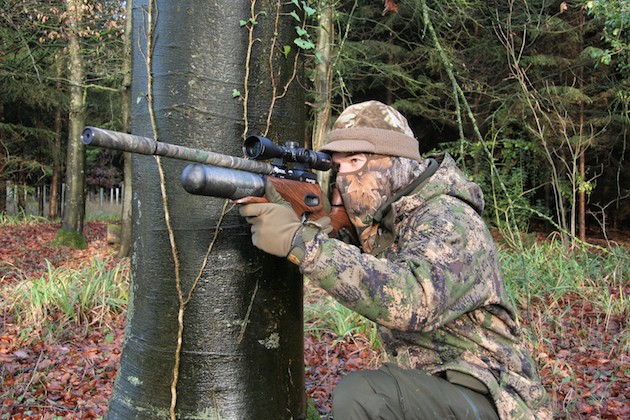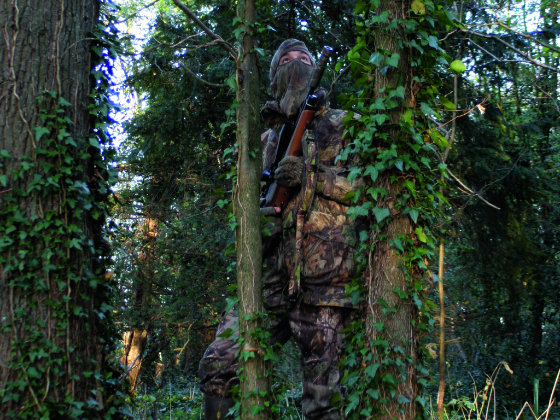Win CENS ProFlex DX5 earplugs worth £1,149 – enter here
Camouflage for airgunning: what’s the best pattern?
 Sophisticated flagship models represent the pinnacle of airgun design but might just be too much gun for some applications.
Sophisticated flagship models represent the pinnacle of airgun design but might just be too much gun for some applications.
Q: I’m new to airgun hunting and plan to invest in camouflage for airgunning so I can get closer to my quarry. What’s the best pattern to go for?
A: It’s difficult to recommend one camouflage pattern over another, but it makes sense to choose one that gives a close match to the landscape where you shoot. For most British shooters, that means a mixture of greens and browns with the odd patch of black, grey and white.
Camouflage for airgunning
I would warn against getting too obsessed with camouflage clothing, though. Keeping your hands and face covered can make a real difference when targeting sharp-eyed quarry, but fieldcraft will always play a more significant role than the latest camouflage pattern. Whatever you are wearing, one of the best ways to go unseen is to keep still and make the most of natural cover. (Read through our list of the best camouflage jackets.)

Camouflage patterns help with concealment but you can still enjoy success with your airgun without them
Do I need to wear head to toe camo?
Q: I recently kitted myself out with a pre-charged airgun and, having spent much of my free time practising on paper targets (discover our list of the best airgun targets, I feel that I’m a good enough shot to tackle live quarry. My only concern is that most airgun shooters wear a lot of leaf-print camouflage clothing, and it is going to take me a while to save up for a set. Is it possible to get close enough to airgun quarry such as rabbits and wood pigeon without being dressed from head to toe in camouflage clothing?
A: You are certainly right about airgun shooters liking their camouflage clothing, and I usually reach for leaf-print jacket, trousers and headnet when heading out with my air rifle. There is no denying that a camo pattern, which helps you blend in with your surroundings, will improve your concealment, but it is certainly not essential.
Can you wear tweed?
A reader recently asked me the following question.
“I am new to airgun shooting and want to buy a proper shooting jacket for my days in the field. I have noticed that most serious airgunners wear a lot of camouflage. Is this essential, or could I get away with a traditional tweed or olive-coloured jacket?”
I replied: Airgun shooters do like to dress in camouflage clothing, and the general belief is that it helps us to get closer to wary quarry. Bearing in mind that many pest species are thought to see in monochrome, it is debatable just how much of a difference modern camouflage patterns actually make, though I do think they help to breed confidence. As far as concealment goes, the most important thing your clothing needs to do is disguise your human form, and I believe that using a head net to cover your face can play a big part in that. As for your jacket, as long as you make the most of natural cover and keep movement to a minimum, I don’t think that tweed or olive colours will place you at any serious disadvantage
Keeping still is the key
I think the best way to go undetected in the countryside is to keep still, as it immediately cuts out the movement and sound that tends to attract the attention of wary quarry. Dress in drab clothing (preferably in soft greens and browns) and you should be able to ambush rabbits and pigeon without splashing out on the latest camo patterns. The fieldcraft skills you learn during these early forays should make you an even more effective hunter when you are able to kit yourself out with specialist clothing.
Related Articles
Get the latest news delivered direct to your door
Subscribe to Shooting Times & Country
Discover the ultimate companion for field sports enthusiasts with Shooting Times & Country Magazine, the UK’s leading weekly publication that has been at the forefront of shooting culture since 1882. Subscribers gain access to expert tips, comprehensive gear reviews, seasonal advice and a vibrant community of like-minded shooters.
Save on shop price when you subscribe with weekly issues featuring in-depth articles on gundog training, exclusive member offers and access to the digital back issue library. A Shooting Times & Country subscription is more than a magazine, don’t just read about the countryside; immerse yourself in its most authoritative and engaging publication.







